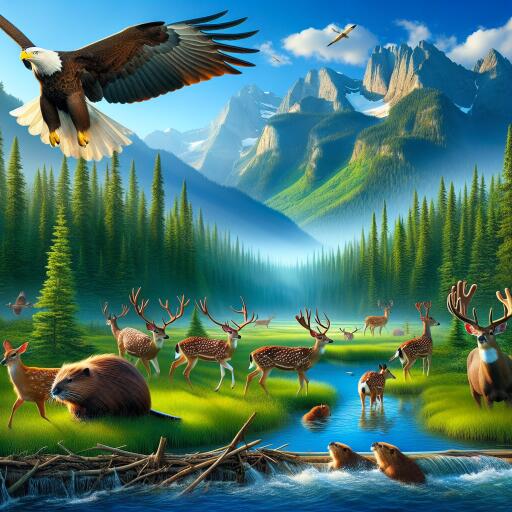
Wildlife: An Integral Part of Earth’s Ecosystem
Wildlife encompasses the vast variety of non-domesticated animals, plants, fungi, and other organisms that thrive in natural environments. Ranging from the tiniest of insects to the largest land mammals, these species play pivotal roles in sustaining ecological equilibrium and supporting the life systems on Earth. Wildlife has long captivated human interest and is fundamental for cultural, economic, and environmental sustainability.
The Importance of Wildlife
Ecological Balance
In the tapestry of natural ecosystems, wildlife serves as the key thread maintaining ecological stability. Predators keep prey populations in check, herbivores manage vegetation levels, and scavengers process decay, ensuring a balance within the food chain. This symbiotic relationship ensures the continued health and functioning of ecosystems.
- Pollination: Countless insects, birds, and bats facilitate plant pollination, a crucial process for food production worldwide.
- Seed Dispersal: Animals like elephants and birds distribute seeds, fostering plant growth and forest renewal.
- Nutrient Cycling: Decomposers, such as earthworms and fungi, break down organic material, recycling essential nutrients back into the ecosystem.
Economic Contributions
Wildlife significantly bolsters economies through various sectors:
- Tourism: Wildlife-related activities, such as safaris and birdwatching, draw millions of visitors, generating substantial income.
- Agriculture: Species that pollinate crops and control pests are indispensable to agricultural productivity.
- Medicine: Many pharmaceutical compounds are derived from wildlife, including cancer-treatment drugs.
Cultural and Aesthetic Significance
Wildlife holds profound spiritual, cultural, and recreational significance. Indigenous peoples often regard animals as sacred. Across various cultures, wildlife is woven into art, folklore, and religion. The natural world inspires creativity and peacefulness, promoting well-being and mental health.
Challenges Facing Wildlife
Despite its immense value, wildlife confronts significant dangers due to anthropogenic activities and environmental modifications:
Habitat Loss and Fragmentation
The erosion and division of habitats, driven by deforestation, urban sprawl, and agriculture, pose a severe threat. Iconic regions like the Amazon rainforest are rapidly diminishing under such pressures.
Climate Change
Altered temperatures, shifting precipitation patterns, and extreme weather events disrupt ecosystems, endangering species unable to adapt. Examples include polar bears losing their icy domains as glaciers melt.
Pollution
Industrial, agricultural, and urban pollutants contaminate terrestrial and aquatic environments, imperiling countless forms of life.
Overexploitation
The relentless overfishing, hunting, and poaching of species have decimated populations, threatening animals like elephants and rhinos with extinction due to the illegal trade in their parts.
Invasive Species
Non-native species, when introduced to new regions, can devastate native populations by preying on, outcompeting, or introducing diseases to them.
Emerging Diseases
Diseases transmitted from humans or domestic animals are increasingly impacting wildlife, with devastating effects on global populations.
Conservation Efforts
Addressing these threats requires comprehensive strategies to preserve wildlife:
Protected Areas
By establishing reserves and national parks, safe refuges for wildlife are created. These include celebrated places like Serengeti National Park and the Sundarbans.
Legislative Measures
Governments and international bodies have enacted laws to shield wildlife, such as the Convention on International Trade in Endangered Species (CITES) and domestic endangered species legislation.
Wildlife Corridors
Connecting isolated habitats using corridors facilitates animal movement, aiding in their survival and reproduction.
Community Involvement
Engaging local communities in conservation endeavors promotes sustainable practices and aligns economic incentives with wildlife preservation, evident in programs like eco-tourism.
Ex-situ Conservation
Efforts to conserve species outside of their natural habitats, through zoos and seed banks, are vital for species on the brink of extinction.
Innovative Technology
Advanced technological tools like camera traps, drones, and DNA analysis bolster conservation efforts by improving monitoring, protection, and understanding of biodiversity.
Conservation Success Stories
While challenges abound, some efforts have yielded triumphs:
- Tiger Conservation: Initiatives have seen tiger numbers rebound in India.
- Bald Eagles: Legal protections have helped recover these majestic birds in the U.S.
- Mountain Gorillas: Intensive protection has led to a resurgence in their populations.
Individual Contributions to Conservation
Everyone has a role in conserving wildlife:
- Minimizing waste, particularly plastic, is crucial for reducing pollution.
- Supporting sustainable products and practices contributes to ecological balance.
- Participating in conservation projects or advocating for wildlife protection raises awareness.
- Collaborating with conservation organizations strengthens communal efforts.
Looking Ahead
The future of wildlife depends critically on our collective efforts to tackle the root causes threatening their survival. Achieving environmental and developmental harmony is crucial for ensuring Earth’s biodiversity thrives for future generations. Rewilding projects, global cooperation to curb wildlife trafficking, and meeting biodiversity targets are essential endeavors.
In conclusion, wildlife is a vital component of Earth’s biodiversity framework. As the source of ecological balance, cultural richness, and economic prosperity, it faces unprecedented threats primarily due to human activity. Conservation is imperative not just ethically but as a cornerstone for safeguarding the innumerable life forms that call our planet home. Active awareness, practical action, and unwavering collaboration can ensure we safeguard our natural legacy and secure a vibrant future.





Leave a Reply